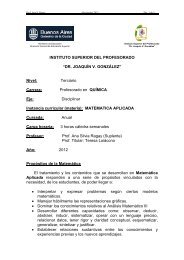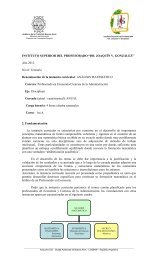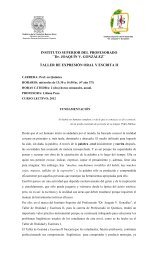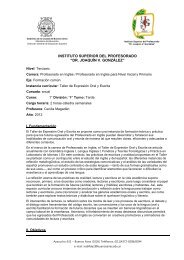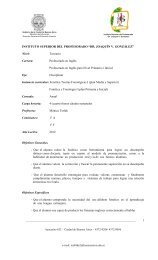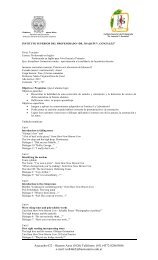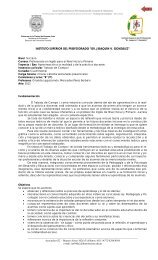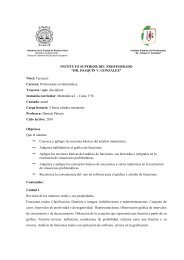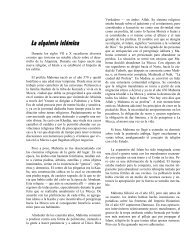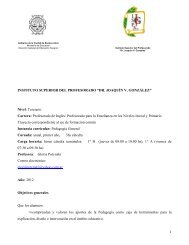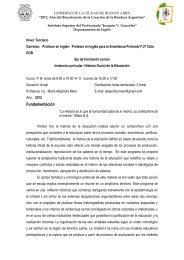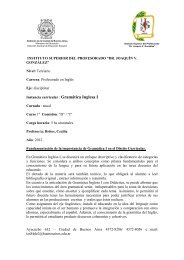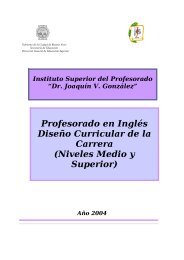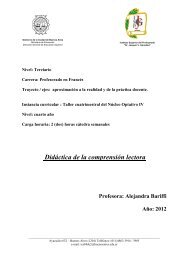Sesiones parale<strong>la</strong>s / Parall<strong>el</strong> sessionsgraphy (especially biographical), other writt<strong>en</strong> sources and interviews un<strong>de</strong>rthe paradigm of Oral History, the circumstances of the philosopher’s visit toB<strong>el</strong>o Horizonte, betwe<strong>en</strong> may 29 and 31 st may of 1973. Its main objective is toestablish an audiography of Foucault amongst us, in other words, both the discursiveor<strong>de</strong>r in which his word was submitted as the disor<strong>de</strong>r that such wor<strong>de</strong>v<strong>en</strong>tually imprinted on the same or<strong>de</strong>r. Furthermore, it takes un<strong>de</strong>r consi<strong>de</strong>rationthat Foucault always emphasized that the truth, instead of awaitingfor our sight, has its own geography and chronology. The informal speechesat the Aliança Francesa and the c<strong>la</strong>ss ministered at the Faculda<strong>de</strong> <strong>de</strong> Filosofiae Ciências Humanas, as w<strong>el</strong>l as the confer<strong>en</strong>ces at Clínica André Luís and Casa<strong>de</strong> Saú<strong>de</strong> Santa C<strong>la</strong>ra are focused. A special emphasis is giv<strong>en</strong> at the press re<strong>la</strong>tions:Foucault’s pres<strong>en</strong>ce is giv<strong>en</strong> during the Brazilian military dictatorshipand, at the time, he <strong>de</strong>v<strong>el</strong>ops a critical analysis of this activity — being eitherthe bourgeois or the allegedly left wing press —, at the same time that he seesin philosophy its<strong>el</strong>f a form of radical journalism. Ought to be ad<strong>de</strong>d that therecourse to Oral History – interviews with people who met the philosopher in1973 – aims at exploring memories about the character-Foucault and his i<strong>de</strong>as,in a search for the instituted (memorable and commemorated) as much as forthe unexpected narratives that contribute to new lines of investigation.COSTA CARDOSO, Lucilei <strong>de</strong>O Imaginário Político das Memórias (Brasil 1964-1985).O propósito da comunicação é analisar a trajetória <strong>de</strong> alguns autores queproduziram livros <strong>de</strong> memórias repres<strong>en</strong>tativos do período da luta armadano Brasil. Os que referem-se ao tema da repressão política possuem um fortecaráter <strong>de</strong> <strong>de</strong>núncia do que <strong>de</strong> fato se passou nos “porões”. Constitui o cern<strong>en</strong>arrativo das memórias <strong>de</strong>scrições sobre o emprego e rotinização da tortura,além das diversas experiências cotidianas para se manterem vivos. A legitimida<strong>de</strong>m<strong>oral</strong> e jurídica <strong>de</strong> tais re<strong>la</strong>tos não nos impe<strong>de</strong> <strong>de</strong> submetê-los ao crivoda crítica e <strong>de</strong> um contexto <strong>de</strong> produção memorialística próprio do seu tempo<strong>de</strong> construção narrativa e circu<strong>la</strong>rida<strong>de</strong>. Apres<strong>en</strong>tamos as difer<strong>en</strong>tes visõesdos memorialistas em torno das características da autocrítica que realizaramdo período da luta armada, buscando um contraponto com outros escritosque se aproximam na perspectiva da resistência heróica <strong>de</strong> alguns militantesdos grupos <strong>de</strong> esquerda que <strong>en</strong>tregaram a sua vida pe<strong>la</strong> causa da revoluçãosocialista.RODEGHERO, Car<strong>la</strong> SimoneAmnistía y olvido: reflexiones a partir <strong>de</strong> testimonios<strong>de</strong>l Proyecto Marcas <strong>de</strong> <strong>la</strong> Memoria: Historia Oral <strong>de</strong><strong>la</strong> Amnistía <strong>en</strong> BrasilEste texto trabaja con <strong>el</strong> conjunto <strong>de</strong> <strong>la</strong>s <strong>en</strong>trevistas <strong>de</strong> “<strong>historia</strong> <strong>oral</strong>” hechaspara <strong>el</strong> proyecto “Marcas <strong>de</strong> <strong>la</strong> memoria: Historia <strong>oral</strong> <strong>de</strong> <strong>la</strong> amnistía <strong>en</strong> Brasil”,tratando <strong>de</strong> <strong>en</strong>t<strong>en</strong><strong>de</strong>r como los antiguos perseguidos políticos por <strong>la</strong> dictaduracívico-militar v<strong>en</strong> y califican <strong>la</strong>s re<strong>la</strong>ciones <strong>en</strong>tre amnistía y olvido. El proyectoes una iniciativa <strong>de</strong> Comisión <strong>de</strong> Amnistía <strong>de</strong>l Ministerio Fe<strong>de</strong>ral <strong>de</strong> Justicia,creada para administrar <strong>el</strong> proceso <strong>de</strong> reparaciones financieras por persecuciónpolítica, estando a cargo <strong>de</strong> un equipo <strong>de</strong> pesquisidores <strong>de</strong> tres universida<strong>de</strong>sbrasileñas. Serán analizados los testimonios recogidos por <strong>el</strong> equipo <strong>de</strong>Universidad Fe<strong>de</strong>ral <strong>de</strong> Rio Gran<strong>de</strong> do Sul, coordinado por <strong>la</strong> propon<strong>en</strong>te <strong>de</strong>lpres<strong>en</strong>te trabajo. La referida comisión, a<strong>de</strong>más <strong>de</strong> recibir y juzgar los pedidos<strong>de</strong> in<strong>de</strong>mnización, ha creado proyectos que buscan <strong>el</strong> rescate <strong>de</strong> <strong>la</strong> memoriaacerca <strong>de</strong> <strong>la</strong> represión y resist<strong>en</strong>cia al régim<strong>en</strong> dictatorial <strong>en</strong> comparación conlos casos <strong>de</strong> otros países como por ejemplo <strong>la</strong> Arg<strong>en</strong>tina, <strong>en</strong> <strong>el</strong> s<strong>en</strong>tido <strong>de</strong> g<strong>en</strong>eraruna justicia <strong>de</strong> transición. El análisis t<strong>en</strong>drá como eje <strong>de</strong>ve<strong>la</strong>r cómo <strong>la</strong>spersonas <strong>en</strong>trevistadas califican <strong>la</strong>s iniciativas <strong>de</strong> <strong>la</strong> Comisión <strong>de</strong> Amnistía, <strong>en</strong>especial <strong>la</strong>s in<strong>de</strong>mnizaciones pagadas, y <strong>la</strong> re<strong>la</strong>ción <strong>de</strong> esos pagos y <strong>la</strong> Ley <strong>de</strong>Amnistía <strong>de</strong> 1979, que por lo g<strong>en</strong>eral es percibida como un instrum<strong>en</strong>to <strong>de</strong> olvido<strong>de</strong>l pasado dictatorial, especialm<strong>en</strong>te <strong>en</strong> sus aspectos represivos.This article explores a series of <strong>oral</strong> history interviews ma<strong>de</strong> during the project“Marcas da Memória: História Oral da Anistia no Brasil”, seeking the perceptionsof former victims of political persecution from the Brazilian’s dictatorshipin the period after 1964 about the re<strong>la</strong>tionship betwe<strong>en</strong> amnesty and oblivion.The project is an initiative of the Amnesty Commission of the Brazil’s Ministryof Justice, which is a governm<strong>en</strong>tal body created to manage the financial reparationsdue to the political persecution. The project has be<strong>en</strong> conducted by ateam of researchers from three Brazilian universities. The analyzed interviewswere ma<strong>de</strong> by the researchers from <strong>de</strong> Fe<strong>de</strong>ral University of Rio Gran<strong>de</strong> do Sul,coordinated by the propon<strong>en</strong>t of this paper.Besi<strong>de</strong>s receiving and judging c<strong>la</strong>ims for financial reparations, this Commissionhad implem<strong>en</strong>ted projects that aimed the rescuing of the memory of repressionand resistance do the dictatorship, creating a dialogue with the experi<strong>en</strong>cesfrom other countries, such as Arg<strong>en</strong>tina, in the search for carrying outa transitional justice. The proposed analysis will focus on how the interviewedpeople evaluate the initiatives of the Amnesty Commission, especially the financialreparations that was paid, and the re<strong>la</strong>tionship drawn betwe<strong>en</strong> themand the Amnesty Act of 1979, g<strong>en</strong>erally un<strong>de</strong>rstood as a mean for forgetting thedictatorship past, especially the suffered repression.SANTOS ROLEMBERG CÔRTES, JoanaDiálogos con ex presos políticos <strong>en</strong> Pernambuco,Nor<strong>de</strong>ste <strong>de</strong> Brasil: Un estudio sobre <strong>la</strong> experi<strong>en</strong>cia<strong>de</strong> lo cotidiano <strong>de</strong> <strong>la</strong> represión y <strong>de</strong> <strong>la</strong> resist<strong>en</strong>cia <strong>en</strong><strong>la</strong> cárc<strong>el</strong> <strong>de</strong> <strong>la</strong> dictadura brasileiraBrasil aun está lejos <strong>de</strong> concluir o proceso <strong>de</strong> e<strong>la</strong>boración y reflexión críticasobre <strong>el</strong> pasado <strong>de</strong> <strong>la</strong> dictadura civil-militar, que gobernó <strong>en</strong>tre 1964 y 1985. Elrechazo <strong>de</strong> <strong>la</strong> propuesta <strong>de</strong> revisión <strong>de</strong> <strong>la</strong> Ley <strong>de</strong> Amnistía, por <strong>el</strong> Supremo TribunalFe<strong>de</strong>ral brasilero, <strong>en</strong> abril <strong>de</strong> 2010; <strong>la</strong> legis<strong>la</strong>ción que restringe <strong>el</strong> accesoa los docum<strong>en</strong>tos reservados <strong>en</strong> los archivos militares; <strong>la</strong> negativa a asumir <strong>la</strong>responsabilidad por los crím<strong>en</strong>es <strong>de</strong> torturas y asesinatos políticos y los conflictos<strong>de</strong>l <strong>de</strong>recho a <strong>la</strong> memoria y a <strong>la</strong> verdad, son sólo algunos <strong>de</strong> los puntostan actuales como neurálgicos <strong>de</strong> ese proceso histórico sobre <strong>el</strong> pasadoreci<strong>en</strong>te –y PRESENTE- <strong>de</strong> autoritarismo político y vio<strong>la</strong>ción <strong>de</strong> los <strong>de</strong>rechoshumanos <strong>en</strong> <strong>el</strong> país.Por otro <strong>la</strong>do, estudios historiográficos significativos que analizan experi<strong>en</strong>cias,traumas sociales y individuales y dim<strong>en</strong>siones diversas <strong>de</strong> <strong>la</strong> memoriasocial provocada por <strong>la</strong> dictadura civil-militar <strong>en</strong> <strong>el</strong> Brasil, han sido publicados<strong>en</strong> los últimos años.Entre los estudios producidos <strong>en</strong> <strong>la</strong>s universida<strong>de</strong>s brasileras, aun hay pocos<strong>en</strong>focados <strong>en</strong> <strong>la</strong> experi<strong>en</strong>cia <strong>de</strong> presos políticos <strong>en</strong> <strong>la</strong>s cárc<strong>el</strong>es <strong>de</strong>l país, especialm<strong>en</strong>tesobre aqu<strong>el</strong>los <strong>de</strong> fuera <strong>de</strong>l eje Rio-São Paulo, como es <strong>el</strong> caso <strong>de</strong> los<strong>de</strong> <strong>la</strong> región Nor<strong>de</strong>ste.A través <strong>de</strong>l uso <strong>de</strong> <strong>la</strong> Historia Oral, este texto pres<strong>en</strong>ta una análisis <strong>de</strong> los primerosresultados <strong>de</strong> <strong>en</strong>trevistas con ex presos políticos y se <strong>de</strong>dica a compreh<strong>en</strong><strong>de</strong>r<strong>la</strong>s difer<strong>en</strong>tes experi<strong>en</strong>cias <strong>de</strong> represión y resist<strong>en</strong>cia socializadas <strong>en</strong>lo cotidiano <strong>en</strong>tre <strong>el</strong><strong>la</strong>s <strong>la</strong>s <strong>de</strong> <strong>la</strong> P<strong>en</strong>it<strong>en</strong>ciaria Barreto Camp<strong>el</strong>o, <strong>en</strong>tre 1973 y1979, <strong>en</strong> <strong>el</strong> estado <strong>de</strong> Pernambuco.El pres<strong>en</strong>te trabajo hace parte <strong>de</strong> una investigación que procura reflexionarsobre <strong>la</strong> forma como se da <strong>la</strong> re<strong>la</strong>ción <strong>de</strong> siete ex presos políticos con <strong>la</strong> memoriapres<strong>en</strong>te <strong>de</strong> un pasado colectivo, <strong>el</strong> <strong>de</strong> <strong>la</strong> dictadura brasileira. Procurocompr<strong>en</strong><strong>de</strong>r, a través <strong>de</strong> <strong>la</strong>s narrativas <strong>oral</strong>es, los mecanismos <strong>de</strong> represión<strong>de</strong>l Estado <strong>en</strong> <strong>la</strong> prisión y <strong>la</strong>s estrategias <strong>de</strong> sobreviv<strong>en</strong>cia y <strong>de</strong> apr<strong>en</strong>dizaje, <strong>de</strong>reorganización <strong>de</strong> i<strong>de</strong>ntida<strong>de</strong>s y <strong>de</strong> resist<strong>en</strong>cia <strong>de</strong> esos sujetos políticos <strong>de</strong>ntro<strong>de</strong> <strong>la</strong> cárc<strong>el</strong>, contra <strong>la</strong> dictadura <strong>en</strong> <strong>el</strong> Brasil.KOTLER, RubénLas particu<strong>la</strong>rida<strong>de</strong>s <strong>de</strong>l re<strong>la</strong>to <strong>en</strong> los testimonios <strong>de</strong>los familiares <strong>de</strong> <strong>de</strong>saparecidos <strong>en</strong> Arg<strong>en</strong>tina. El casoTucumánDes<strong>de</strong> 1977 hasta <strong>la</strong> actualidad, atravesando distintas etapas, se configuró <strong>en</strong><strong>el</strong> espacio <strong>de</strong> <strong>la</strong> provincia <strong>de</strong> Tucumán, Arg<strong>en</strong>tina, lo que po<strong>de</strong>mos <strong>de</strong>nominar<strong>el</strong> movimi<strong>en</strong>to <strong>de</strong> <strong>de</strong>rechos humanos local. Algunas <strong>de</strong> <strong>la</strong>s organizaciones qu<strong>el</strong>o conforman están estrecham<strong>en</strong>te vincu<strong>la</strong>das por fuertes re<strong>la</strong>ciones <strong>de</strong> par<strong>en</strong>tescocon los <strong>de</strong>saparecidos <strong>en</strong> <strong>la</strong> última dictadura militar (1976 – 1983).Estudiar al movimi<strong>en</strong>to a partir <strong>de</strong> los testimonios <strong>de</strong> sus integrantes, suponerealizar un análisis <strong>de</strong> lo particu<strong>la</strong>r <strong>de</strong> cada re<strong>la</strong>to, particu<strong>la</strong>rida<strong>de</strong>s que estándadas por <strong>la</strong> especificidad <strong>de</strong> los testimonios. Si como afirma DominickLaCapra “<strong>el</strong> testimonio <strong>de</strong> los sobrevivi<strong>en</strong>tes, incluido <strong>el</strong> proceso mismo <strong>de</strong><strong>la</strong>s <strong>en</strong>trevistas, es <strong>en</strong> cierta manera un nuevo género que se está haci<strong>en</strong>do,necesariam<strong>en</strong>te problemático, que ti<strong>en</strong>e consecu<strong>en</strong>cias <strong>en</strong> <strong>la</strong> <strong>historia</strong> <strong>oral</strong>,especialm<strong>en</strong>te <strong>en</strong> <strong>la</strong>s áreas <strong>de</strong> investigación más <strong>de</strong>licadas.” Y que “los <strong>historia</strong>dorestodavía no han e<strong>la</strong>borado <strong>de</strong>l todo una manera aceptable <strong>de</strong> “usar”los testimonios, y <strong>la</strong>s profundas difer<strong>en</strong>cias <strong>en</strong>tre <strong>el</strong> estado y <strong>la</strong> experi<strong>en</strong>cia <strong>de</strong><strong>la</strong>s distintas víctimas así como <strong>en</strong>tre <strong>la</strong>s diversas respuestas que suscitan nohac<strong>en</strong> más que complicar su tarea” (LaCapra: 2005: 127), <strong>en</strong>tonces se hace necesarioanalizar <strong>la</strong> especificidad <strong>de</strong> los re<strong>la</strong>tos <strong>de</strong> los familiares <strong>de</strong> <strong>la</strong>s víctimas,re<strong>la</strong>tos que cargan con toda <strong>la</strong> <strong>historia</strong> y experi<strong>en</strong>cia vividas y que se sitúansiempre <strong>en</strong> <strong>el</strong> pres<strong>en</strong>te <strong>de</strong>l testimoniante. Lo que me propongo <strong>en</strong>tonces <strong>en</strong> <strong>la</strong>pres<strong>en</strong>te pon<strong>en</strong>cia, es analizar alguna <strong>de</strong> estas especificida<strong>de</strong>s, verificar quédistingue <strong>el</strong> testimonio <strong>de</strong> los familiares <strong>de</strong> los represaliados <strong>de</strong> otros testimoniosy <strong>en</strong> todo caso, exponer <strong>en</strong> un primer acercami<strong>en</strong>to al tema, algunascuestiones referidas a los testimonios <strong>en</strong> sí, a <strong>la</strong>s actitu<strong>de</strong>s narrativas <strong>de</strong> los<strong>en</strong>trevistados y al resultado <strong>de</strong> unas <strong>en</strong>trevistas <strong>en</strong> <strong>la</strong>s cuales es posible <strong>en</strong>contrarexpectación, <strong>de</strong>silusión, tristeza y esperanza que conecta <strong>el</strong> pasado, con98
Sesiones parale<strong>la</strong>s / Parall<strong>el</strong> sessions<strong>el</strong> pres<strong>en</strong>te <strong>de</strong> los testimoniantes y <strong>el</strong> futuro como meta. En síntesis, lo que mepropongo es analizar algunos testimonios y ubicar su especificidad <strong>de</strong>s<strong>de</strong> <strong>la</strong>particu<strong>la</strong>ridad <strong>de</strong> los testimoniantes: militantes <strong>de</strong>l movimi<strong>en</strong>to <strong>de</strong> <strong>de</strong>rechoshumanos <strong>de</strong> Tucumán.GARTNER, AliciaLa p<strong>la</strong>nta G<strong>en</strong>eral Motors <strong>en</strong> Barracas: testimonios<strong>de</strong> los conflictos obreros durante los primeros años<strong>de</strong> <strong>la</strong> dictaduraEn este trabajo pret<strong>en</strong><strong>de</strong>mos realizar, a partir <strong>de</strong> testimonios <strong>oral</strong>es, algunosaportes a <strong>la</strong> visualización <strong>de</strong> <strong>la</strong> lucha <strong>de</strong> los obreros <strong>de</strong> <strong>la</strong> empresa G<strong>en</strong>eral Motors,durante los primeros años <strong>de</strong> <strong>la</strong> última dictadura militar <strong>en</strong> <strong>la</strong> Arg<strong>en</strong>tina.La investigación se focaliza <strong>en</strong> <strong>la</strong> p<strong>la</strong>nta industrial que <strong>la</strong> G<strong>en</strong>eral Motors t<strong>en</strong>ía<strong>en</strong> <strong>el</strong> barrio <strong>de</strong> Barracas <strong>de</strong> <strong>la</strong> cuidad <strong>de</strong> Bu<strong>en</strong>os Aires.A partir <strong>de</strong>l año 1976 hasta 1978, año <strong>en</strong> <strong>la</strong> que <strong>la</strong> p<strong>la</strong>nta <strong>de</strong>jó <strong>de</strong> producir, <strong>la</strong>empresa tomó una serie <strong>de</strong> medidas referidas a <strong>de</strong>spidos y a <strong>la</strong> restructuración<strong>de</strong>l trabajo, que provocaron <strong>la</strong> resist<strong>en</strong>cia <strong>de</strong> sus trabajadores y los consecu<strong>en</strong>tesconflictos <strong>la</strong>b<strong>oral</strong>es. En <strong>el</strong> marco <strong>de</strong>l Terrorismo <strong>de</strong> Estado imperante, <strong>la</strong>represión sobre los obreros se hizo s<strong>en</strong>tir.<strong>Los</strong> testimonios <strong>oral</strong>es <strong>de</strong> los trabajadores <strong>en</strong>trevistados nos permit<strong>en</strong>acercarnos a <strong>la</strong> situación previa al golpe <strong>de</strong> Estado <strong>en</strong> dicha p<strong>la</strong>nta, y a loscambios que se produjeron a partir <strong>de</strong>l mismo. Particu<strong>la</strong>rm<strong>en</strong>te, <strong>en</strong> lo queconcierne al <strong>de</strong>sarrollo <strong>de</strong> los <strong>en</strong>fr<strong>en</strong>tami<strong>en</strong>tos con <strong>la</strong> patronal y al sufrimi<strong>en</strong>topa<strong>de</strong>cido con <strong>la</strong> interv<strong>en</strong>ción <strong>de</strong>l aparato represivo. Al re<strong>la</strong>tar susviv<strong>en</strong>cias, los obreros <strong>en</strong>trevistados nos aportan, a<strong>de</strong>más, cómo era <strong>el</strong> proceso<strong>de</strong> producción y cómo fueron cambiando <strong>la</strong>s condiciones <strong>la</strong>b<strong>oral</strong>es <strong>en</strong><strong>la</strong>s distintas líneas <strong>de</strong> producción <strong>de</strong>spués <strong>de</strong>l golpe, que cerc<strong>en</strong>ó sus <strong>de</strong>rechos<strong>la</strong>b<strong>oral</strong>es. <strong>Los</strong> protagonistas rememoran hoy, cómo sostuvieron losconflictos <strong>en</strong> un marco nacional absolutam<strong>en</strong>te adverso a cualquier tipo<strong>de</strong> rec<strong>la</strong>mo. Esto nos permite abonar <strong>la</strong> postura <strong>de</strong> <strong>la</strong> exist<strong>en</strong>cia <strong>de</strong> una luchaobrera <strong>de</strong> oposición a <strong>la</strong> dictadura, que algunas líneas historiográficas<strong>de</strong>sdibujan.The aim of this work is to make some contributions to the visualization of thefight of the workers of the G<strong>en</strong>eral Motors company, during the first years ofthe military dictatorship in the Arg<strong>en</strong>tina from <strong>oral</strong> testimonies.The research focuses on industrial p<strong>la</strong>nt that G<strong>en</strong>eral Motors had in Barracasdistrict of the city of Bu<strong>en</strong>os Aires.From the year 1976 until 1978, year in which the p<strong>la</strong>nt ceased production, thecompany took a series of measures re<strong>la</strong>ting to dismissals and the restructuringof the work, which led to the resistance of its workers and the resulting <strong>la</strong>bourdisputes. In the framework of the prevailing state terrorism, repression wasf<strong>el</strong>t on the workers.The <strong>oral</strong> testimonies provi<strong>de</strong>d by the interviewed workers, allows us toapproach to the situation prior to the military dictatorship in the p<strong>la</strong>nt andthe changes produced from it, especially in what concerns the <strong>de</strong>v<strong>el</strong>opm<strong>en</strong>tof c<strong>la</strong>shes with employers and the suffering <strong>en</strong>dured with the interv<strong>en</strong>tion ofthe governm<strong>en</strong>t .To re<strong>la</strong>te their experi<strong>en</strong>ces, the interviewed workers bring us testimonies ofhow was the production process and how were changing the working conditionsin the differ<strong>en</strong>t lines of production after the military dictatorship, whichharmed their <strong>la</strong>bour rights. The protagonist recall today how did they fight fortheir rights within a national framework quite averse to any type of c<strong>la</strong>im. Thisallows us to pay the stance of the exist<strong>en</strong>ce of a <strong>la</strong>bor struggle against the dictatorshipthat some historiographical lines blur.——————————————————————————————————————————————C<strong>en</strong>tro <strong>de</strong> Estudios y Formación Marxista——————————————————————————————————————————————Subtema / Subteme 14Memoria, <strong>historia</strong> <strong>oral</strong> y comunidad / Memory, OralHistory and community14 a. Cre<strong>en</strong>cias compartidas, tradiciones r<strong>el</strong>igiosasy transmisión <strong>oral</strong>. Shared B<strong>el</strong>iefs, R<strong>el</strong>igiousTraditions, and the Oral Transmission.14b- Culturas no hegemónicas e <strong>historia</strong> <strong>oral</strong> /Nohegemoniccultures and Oral HistoryMesa / Session 67Coordinan / Chair: Nora Salles——————————————————————————————————————————————MEZA, José AntonioMemoria y peronismo. Una aproximación al surgimi<strong>en</strong>to<strong>de</strong>l peronismo <strong>en</strong> <strong>el</strong> ámbito rural corr<strong>en</strong>tinoa través <strong>de</strong> <strong>la</strong> <strong>historia</strong> <strong>oral</strong>. (1943-1946)La llegada <strong>de</strong>l peronismo al gobierno produjo transformaciones fundam<strong>en</strong>tales<strong>en</strong> todo <strong>el</strong> país y se promovieron importantes avances <strong>en</strong> <strong>la</strong> conquista<strong>de</strong> <strong>la</strong> ciudadanía social y política, con <strong>la</strong> integración <strong>de</strong> vastos sectores. Enestos procesos <strong>la</strong> participación <strong>de</strong> <strong>la</strong> pob<strong>la</strong>ción rural ha sido muy importante,pues hacia 1947 <strong>el</strong> 38% <strong>de</strong> los arg<strong>en</strong>tinos vivía <strong>en</strong> localida<strong>de</strong>s que contabancon m<strong>en</strong>os <strong>de</strong> 2.000 habitantes, número que <strong>en</strong> <strong>la</strong> provincia <strong>de</strong> Corri<strong>en</strong>tesasc<strong>en</strong>día al 60%.Este trabajo pret<strong>en</strong><strong>de</strong> ser una primera aproximación, al estudio <strong>de</strong> <strong>la</strong>s prácticaspolíticas <strong>en</strong> los ámbitos rurales <strong>de</strong> <strong>la</strong> provincia <strong>de</strong> Corri<strong>en</strong>tes, mediante <strong>el</strong>uso <strong>de</strong> <strong>la</strong> Historia Oral. Para <strong>el</strong>lo se t<strong>en</strong>drá <strong>en</strong> cu<strong>en</strong>ta <strong>el</strong> período cronológico1943-1946, vincu<strong>la</strong>do con <strong>el</strong> surgimi<strong>en</strong>to y asc<strong>en</strong>so <strong>de</strong>l peronismo al po<strong>de</strong>r.D<strong>en</strong>tro <strong>de</strong> este marco, <strong>el</strong> ámbito geográfico <strong>de</strong> nuestro estudio, está circunscriptoal <strong>de</strong>partam<strong>en</strong>to G<strong>en</strong>eral Paz, ubicado al norte <strong>de</strong> ésta provincia. Enese contexto, nuestro interrogante apunta a <strong>la</strong>s modalida<strong>de</strong>s <strong>de</strong> <strong>la</strong>s campañaspros<strong>el</strong>itistas <strong>de</strong> los partidos y a <strong>la</strong> manera <strong>en</strong> que <strong>el</strong><strong>la</strong>s eran vividas por parte<strong>de</strong> estos pob<strong>la</strong>dores, como así también <strong>la</strong>s posibles transformaciones que <strong>la</strong>irrupción <strong>de</strong>l peronismo g<strong>en</strong>eró <strong>en</strong> estos ambi<strong>en</strong>tes y <strong>en</strong> <strong>la</strong> sociabilidad política<strong>de</strong> sus habitantes.The arrival of peronism to the governm<strong>en</strong>t produced very important transformationsin all over the country. By 1947 most of the popu<strong>la</strong>tion of Arg<strong>en</strong>tinawas in rural areas, but Corri<strong>en</strong>tes city had the highest rural popu<strong>la</strong>tion of thecountry. The fact is this kind of popu<strong>la</strong>tion did not have access to social and politicalproblems of the country. Therefore, this governm<strong>en</strong>t ma<strong>de</strong> an importantadvance in this aspect; they integrated the vast sectors of the society, consolidatingboth social and political citiz<strong>en</strong>ship.This paper pret<strong>en</strong>ds to be a first approximation to the study of political practicesin rural areas of Corri<strong>en</strong>tes city. Thiswill take into account the chronologicalperiod 1943-1955, which is linked with the rise of Peronism to thepower.Within this framework, the geographical scope of our study is circumscribed toG<strong>en</strong>eral Paz <strong>de</strong>partm<strong>en</strong>t, which is located at the north of Corri<strong>en</strong>tes city.In this context,we will focus on several aspects. First, our question points tothe modalities of pros<strong>el</strong>ytizing propagandas. Secondly, it points on how thesettlers,from whom we received the information, lived those propagandas.Finally, it points to the possible transformations the Peronism produced inboth, the area where the settlers lived, and the political sociability of thesehabitants.PÉREZ, Leydi VivianaLas fu<strong>en</strong>tes <strong>oral</strong>es <strong>en</strong> <strong>el</strong> análisis <strong>de</strong>l f<strong>en</strong>óm<strong>en</strong>o <strong>de</strong> urbanización.Estudio <strong>de</strong> casos: barrios El Ro<strong>de</strong>o y Nueva Floresta<strong>de</strong> Cali, Colombia 1960-1980Esta pon<strong>en</strong>cia aborda <strong>el</strong> análisis <strong>de</strong> un f<strong>en</strong>óm<strong>en</strong>o social significativo <strong>en</strong> <strong>el</strong> contextointernacional, durante <strong>la</strong> segunda mitad <strong>de</strong>l <strong>siglo</strong> XX: <strong>el</strong> proceso <strong>de</strong> toma <strong>de</strong>tierras públicas y privadas, y <strong>de</strong> lucha por <strong>la</strong> vivi<strong>en</strong>da, protagonizado por miles<strong>de</strong> personas que transformaron radicalm<strong>en</strong>te <strong>el</strong> espacio urbano. Cuya investigaciónse realiza a partir <strong>de</strong> dos estudios <strong>de</strong> caso gestados <strong>en</strong> Cali, Colombia–actualm<strong>en</strong>te barrios El Ro<strong>de</strong>o y Nueva Floresta- durante <strong>la</strong> década <strong>de</strong> 1960.En <strong>el</strong><strong>la</strong> se <strong>de</strong>sarrol<strong>la</strong> <strong>la</strong> forma <strong>en</strong> qué los testimonios e <strong>historia</strong>s <strong>de</strong> vida <strong>de</strong>algunos hombres y mujeres migrantes colombianos, que g<strong>en</strong>eran sus discursos<strong>de</strong>s<strong>de</strong> un lugar no hegemónico, constituy<strong>en</strong> aportes significativos a <strong>la</strong> <strong>historia</strong><strong>oral</strong> y barrial <strong>en</strong> América <strong>la</strong>tina. Al ser analizados para interpretar unacoyuntura que durante <strong>el</strong> mismo periodo fue experim<strong>en</strong>tada principalm<strong>en</strong>tepor otros países <strong>la</strong>tinoamericanos, asiáticos y africanos, cuyos habitanteslucharon y resistieron arduam<strong>en</strong>te <strong>en</strong> los espacios urbanos ocupados con <strong>el</strong>objetivo <strong>de</strong> acce<strong>de</strong>r a una vivi<strong>en</strong>da.This paper approaches the analysis of a meaningful social ph<strong>en</strong>om<strong>en</strong>on in theinternational context of the second half of the Tw<strong>en</strong>tieth c<strong>en</strong>tury: the processof taking public and private portions of <strong>la</strong>nd and the fight for dw<strong>el</strong>ling, thisfight was lea<strong>de</strong>d by thousands of people that radically transform the urbanspace. The investigation was performed starting by two study cases <strong>de</strong>v<strong>el</strong>opedin Cali city, Colombia during ninete<strong>en</strong>-sixties in today known as El Ro<strong>de</strong>oand Nueva Floresta towns.In the investigation was <strong>de</strong>v<strong>el</strong>oped the way in that life testimonies and historiesof some Colombian migrating m<strong>en</strong> a wom<strong>en</strong>, that make his discoursesfrom a non hegemonic point of view, make meaningful contributions to the<strong>oral</strong> history of towns in Latin America, being analyzed to give an interpretation of a99



